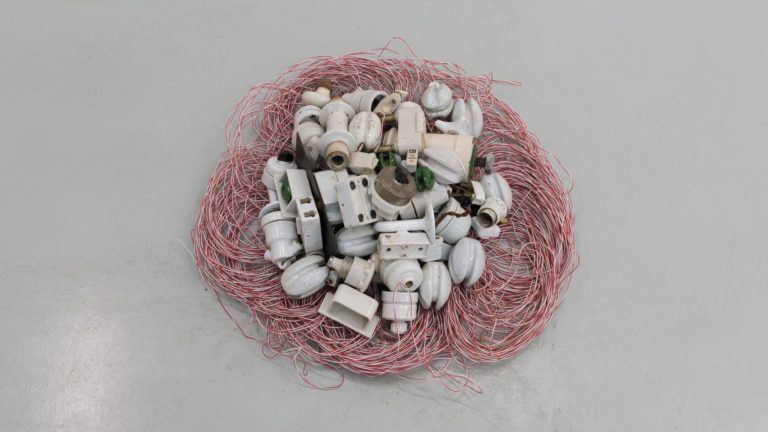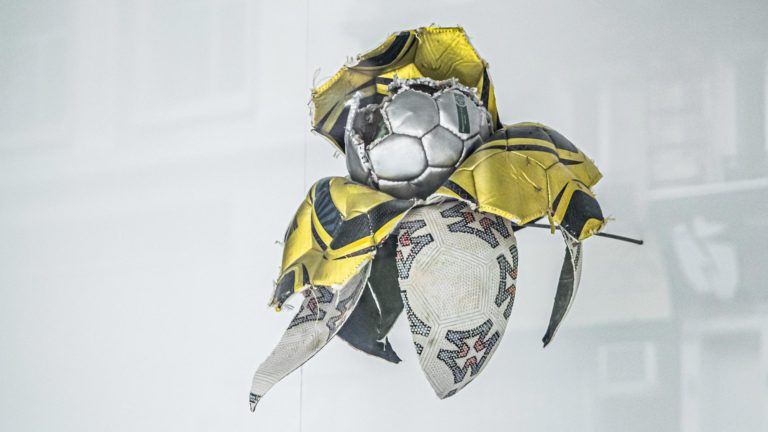Artist: Stéphane Barbier Bouvet
Exhibition title: People
Venue: MANIERA, Brussels, Belgium
Date: November 29, 2019 – February 1, 2020
Photography: all images copyright and courtesy of the artist and MANIERA, Brussels
How can an object exist and cease to exist at one and the same time?
Tim Ingold believes that this happens when the object stops being the object of my attention, when it no longer exists as itself, but becomes its own function: I no longer see my glasses, but I have, in this case, the experience of vision. An object, according to Ingold, needs therefore to disappear in order to exist in a different way, as a tool. Interestingly, Ste?phane Barbier Bouvet’s works are based on a comparable observation – confronting the questions of functionality, reduction, visibility – but the solutions they propose are the opposite of the theory of the British anthropologist. Indeed, if Barbier Bouvet’s method is based on a logic of ‘pulling away’, in the sense of a process of progressive suppression of non-necessary constituents of a manufactured object, searching for the limit, the moment when the fabricated thing is almost no longer an object but continues, despite everything, to function, the forms that this negative system generates, are anything but invisible, quite the opposite.
Nourished by an internal contradiction, which confers on the object its elusiveness, their presence oscillates between a form of impersonality – produced by a concep-tual grid that is almost algorithmic, taking into account the context, its parameters, and proposing answers – and, at the same time a high degree of specificity, bearing the traces of gestures learned and unlearned, of techniques, found or displaced, of bodies, of uses. The double distance they maintain with the contemporary criteria of seduction suggests an origin lying outside even the immediate preoccupations of the industry of objects, mixing in with this other sources, other genealogies, other knowl-edge sets. His works move away from any stylistic functionalization such as a system of aesthetics or an aestheticization of dematerialization: they emerge, in one sense, from a literal correspondence with specific situations, and from a process that strips them, layer after layer, of meaning, ornament and surface. BarbierBouvet exhibits what remains potentially of objects once the film which could still identify them as the subject of design is removed.
The exhibition People organizes and combines various typologies of newly created objects that, while all seemingly referring to an idea of designing and controlling the public space, suggest destinations that remains ambiguous, by reason of their changing functionality and their undecidable materiality and finish. A series of light fittings, produced by hanging opaline tubes around I-beams, is the only source of illumination for the exhibition. Here, the white light of control, of commerce, of 24/7 visibility conquers the interior: the lamps re-enact, inside the gallery space, their ability to regulate the public space with their luminosity. Elsewhere, certain lamps present differences, like an update, but with evolution replaced by devolution, an ossification of the form, its disintegration: with a piece of pylon replacing their LED lighting.
Three urban distribution boxes arranged across the exhibition space recontextualize this invisible object of regulation of the urban system. These caissons, placed under high surveillance by various structures (cities, companies), present a characteristic protective surface, usually enclosing the connectivity that governs the movement of vehicles and machines (traffic lights, trains), communications between individuals and businesses (telephone, Internet), or energy (electricity). BarbierBouvet has chosen three boxes of basic shape and colour, which he has made to undergo a series of transformations. First of all they are presented open. This gesture de-occults a form of secrecy, of power associated with the habitual experience of these symbolic objects. Signs of another form of regulation, this time concerned not with security or economics (as in the case of lamps) but with logistic and transport flows (humans and goods), they become, in a second gesture, cabinets, diverted from their function as if for domestic use: their interior space harbours a light, activated by an automatic switch.
Stéphane Barbier Bouvet’s way of approaching his subjects bears a resemblance to themethodology of the critic, the curator, the designer, and the sculptor.
His work unfolds, simultaneously, as an application (of techniques and principles), a form of knowledge (of the history of design, art, and exhibitions), and a comment (on our relation to the production, dissemination, and circulation of objects).
Stéphane Barbier Bouvet (°1981 in Marseille, lives and works in Brussels) develops different projects, often in the form of a site-specific response to a given situation. Stéphane Barbier Bouvet graduated at École cantonale d’art de Lausanne (ECAL) in 2006, where he soon after opened 1m3, an independent exhibition platform with Benjamin Valenza, Jeanne Graff, and Adrien Missika. Together with Benjamin Valenza, he also initiated Kaiser Kraft, a construction program that works on contracts within the art field. He co-founded the Dirty Art Department at Sandberg Instituut in Amsterdam and has taught classes at different institutions including École Nationale Supérieure des Beaux-Arts de Lyon and Hochschule für Künste in Bremen. He is currently guest tutor at the Design Academy in Eindhoven (Master Social Design).
Over the past years, Barbier Bouvet participated in a wide range of self-initiated, solo, collective and commissioned projects and exhibitions, including most recently the solo shows Design as we Speak at Zaventem Ateliers, After Service at La Loge, Brussels and the traveling exhibition Dating Greek and other beauties at HEAD, Geneva, La Fabbrica, Ascona and La Rada, Locarno. Recent group exhibitions and projects include 1977, une exposition du 40e anniversaire du Centre Pompidou, Centre d’Art de l’Onde, Vélizy; Potemkine Palace, The National Gallery, Sofia and Performing Knowledge at Diensgebäude, Zürich.
Stéphane Barbier Bouvet, People, 2019, exhibition view, MANIERA, Brussels
Stéphane Barbier Bouvet, People, 2019, exhibition view, MANIERA, Brussels
Stéphane Barbier Bouvet, People, 2019, exhibition view, MANIERA, Brussels
Stéphane Barbier Bouvet, People, 2019, exhibition view, MANIERA, Brussels
Stéphane Barbier Bouvet, People, 2019, exhibition view, MANIERA, Brussels
Stéphane Barbier Bouvet, People, 2019, exhibition view, MANIERA, Brussels
Stéphane Barbier Bouvet, People, 2019, exhibition view, MANIERA, Brussels
Stéphane Barbier Bouvet, People, 2019, exhibition view, MANIERA, Brussels
Stéphane Barbier Bouvet, People, 2019, exhibition view, MANIERA, Brussels
Stéphane Barbier Bouvet, People, 2019, exhibition view, MANIERA, Brussels
Stéphane Barbier Bouvet, People, 2019, exhibition view, MANIERA, Brussels
Stéphane Barbier Bouvet, People, 2019, exhibition view, MANIERA, Brussels


















